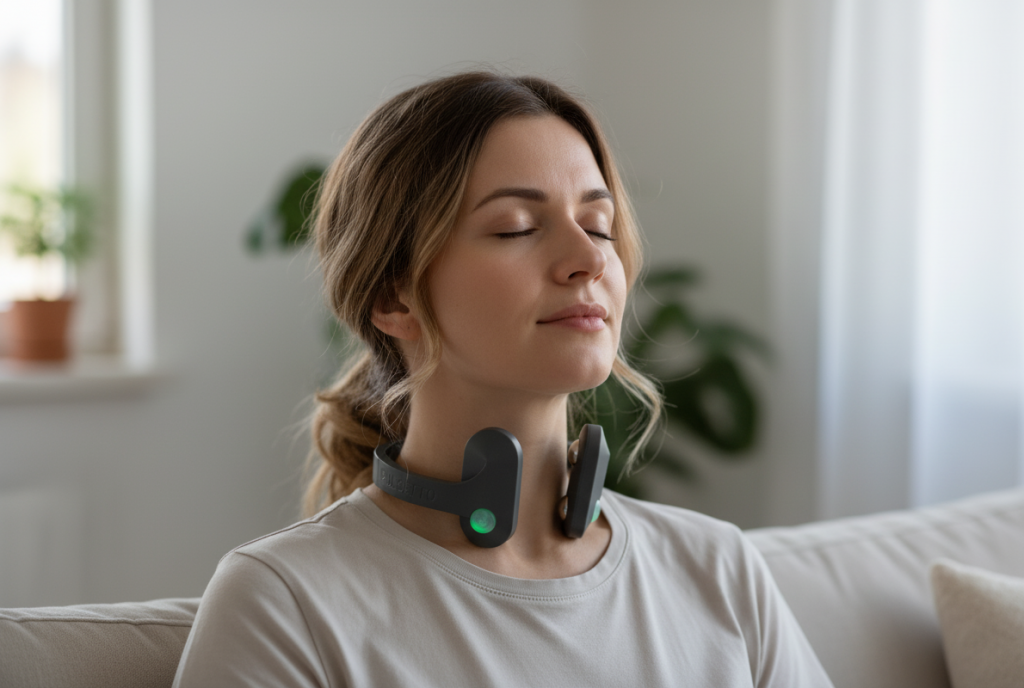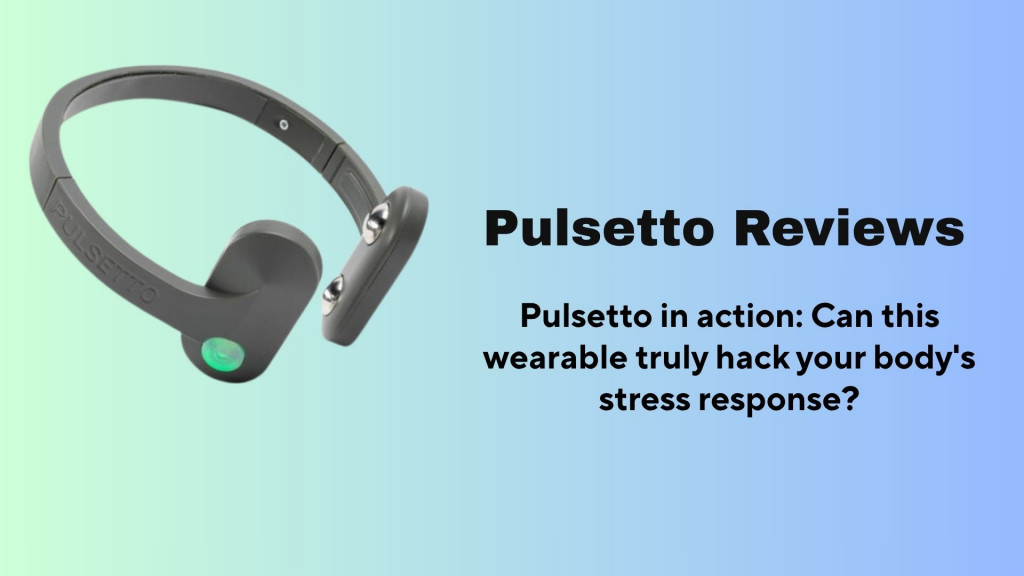
Does Pulsetto Work? An Updated Pulsetto Reviews
Unlock Your Calm for Less! 👉 Click here for an exclusive Pulsetto discount today!
TL;DR: The Pulsetto device offers a non-invasive way to stimulate the vagus nerve, aiming to reduce stress, curb anxiety, and improve sleep. It's an app-controlled neckband that delivers gentle electrical pulses. User experiences are highly polarized. Some report significant calming effects and better sleep within weeks, finding it a valuable wellness tool. Others, however, feel little to no effect, question its objective impact on metrics like Heart Rate Variability (HRV), and note issues with fit for smaller necks. Does Pulsetto work? The answer seems to be highly individual. It's not a magic cure, but for those exploring bio-hacking and non-pharmaceutical stress management, it presents an intriguing option worth considering if you manage expectations.
Modern life feels like a constant barrage of notifications, deadlines, and pressures. The search for calm has become a billion-dollar industry, with everything from meditation apps to weighted blankets promising relief. Entering this crowded space is Pulsetto, a sleek wearable that claims to hack your nervous system for ultimate relaxation. But amidst a sea of glowing testimonials and sharp critiques, the central question remains: Does Pulsetto work?
This comprehensive guide dives deep into Pulsetto reviews, exploring the science, the user experience, and the starkly different outcomes people report. We'll break down how it functions, what the research says, and whether this futuristic gadget is the key to tranquility or just an expensive neck buzzer.
What is Pulsetto and How Does It Claim to Work?
Pulsetto is a wearable device designed to stimulate the vagus nerve. Worn around the back of the neck, it uses a technology called transcutaneous Vagus Nerve Stimulation (tVNS). In simple terms, it sends very low-frequency electrical pulses through the skin to activate this critical nerve.
The Vagus Nerve: Your Body's Built-in Emergency Brake
Think of your nervous system as having two main modes:
Sympathetic Nervous System: This is your "fight-or-flight" response. It gets you ready for action when you perceive a threat, flooding your body with cortisol and adrenaline. It's essential for survival but exhausting when constantly active due to chronic stress.
Parasympathetic Nervous System (PNS): This is your "rest-and-digest" mode. It calms everything down, lowering your heart rate, aiding digestion, and promoting relaxation.
The vagus nerve is the superhighway of your parasympathetic nervous system. It's the longest cranial nerve, wandering from your brain down through your neck to your heart, lungs, and gut. By stimulating this nerve, Pulsetto claims to help you manually switch from a stressed-out "fight-or-flight" state to a calm "rest-and-digest" state. This is the core principle behind the device and the foundation for its purported benefits.
A Deep Dive into Conflicting Pulsetto Reviews
A quick search for Pulsetto reviews reveals a battlefield of opinions. On one side, you have users who call it a "life-changer." On the other, you have disappointed customers and skeptical journalists who report feeling nothing at all. Why the massive difference? Let's dissect the common themes.
The Believers: Reports of Calm and Deeper Sleep
Many positive Pulsetto reviews focus on subjective feelings of well-being. Users often report:
A noticeable sense of calm during and after a session.
Reduced feelings of anxiety when used consistently.
Falling asleep faster and experiencing deeper, more restorative sleep.
Better management of daily stressors.
These users often describe the experience as a "forced meditation," allowing them to take a few minutes out of their day to focus and relax. For them, the physical sensation helps anchor their attention and shift their mental state. The app's simplicity is frequently praised, making it easy to start a session for Stress, Anxiety, or Sleep with just a few taps.
The Skeptics: Questionable Data and Physical Discomfort
Conversely, more critical Pulsetto reviews, like a notable one from WIRED, highlight several key issues:
Lack of Measurable Change: Some users meticulously track their health data (like Heart Rate Variability or HRV via an Apple Watch or Whoop) and see no significant improvement, even after a month of consistent use.
Uncomfortable Sensations: While some find the pulsating "fizzy" feeling relaxing, others find it odd or even unpleasant. At higher intensities, side effects like dizziness, mild nausea, or muscle twitching can occur.
Poor Fit: The device is a fixed size. Several users, particularly those with more slender necks, report that the electrical contacts don't sit properly on the skin, making the device ineffective or unusable.
The Placebo Question: Skeptics argue that the primary benefit may come from simply taking 5-10 minutes to sit quietly and breathe, and the device itself might be a sophisticated placebo.
This divide in Pulsetto reviews suggests that its effectiveness is not universal. Factors like individual physiology, neck anatomy, personal sensitivity to electrical stimulation, and baseline stress levels likely play a huge role.
Limited-Time Offer: Transform Your Stress with Pulsetto! 👉 Grab your special price before it's gone!
Unboxing and Using Pulsetto: A First-Hand Account
To provide a clearer picture, let's walk through the user experience from start to finish.
Setup: Simple and Straightforward
The Pulsetto package is minimalist: the neckband device, a USB-C charging cable, and a small tube of electrode gel. The setup process is refreshingly easy:
Download the Pulsetto app (available on iOS and Android).
Create an account and pair the device via Bluetooth.
Apply a small amount of the conductive gel to the two metal electrodes on the device.
Place the device around your neck, ensuring the electrodes make firm contact with the skin on either side.
The app is clean and intuitive. You simply choose a program—like Stress, Anxiety, Sleep, Burnout, or Pain Management—with sessions ranging from 4 to 20 minutes.
The Sensation: What Does Vagus Nerve Stimulation Feel Like?
This is where experiences diverge. The feeling is often described as a localized, fizzy, or tingling pulse deep in the neck muscles. It’s not painful, but it is certainly a unique sensation. You control the intensity through the app, typically on a scale from 1 to 9. Most users find a comfortable level between 4 and 7.
Anything higher can cause noticeable muscle twitching in the neck and shoulders, which can be distracting. Finding your "sweet spot" is key to a pleasant session. The feeling itself doesn't fundamentally change between modes like "Anxiety" and "Sleep," leading some to believe the different programs are more about mental framing than distinct technological protocols.
👉Don't Miss Out: Experience Pulsetto's Benefits with Our Starter Pack Deal! 👉 Claim your offer here!
Does Pulsetto Work? Examining the Evidence
This is the multi-million dollar question. The answer lies in the intersection of scientific research, anecdotal evidence, and personal biology.
The Science of tVNS
Vagus Nerve Stimulation (VNS) is not a new concept. Surgically implanted VNS devices have been used for decades as an FDA-approved treatment for epilepsy and treatment-resistant depression. The evidence for implanted VNS is robust.
However, Pulsetto uses transcutaneous VNS (tVNS), which is non-invasive. The body of research on tVNS is younger and still growing, but it is promising. Studies have shown that tVNS can influence brain activity, reduce sympathetic nervous system responses, and potentially improve mood and cognitive function. A key challenge highlighted by institutions like the UK's Royal College of Psychiatrists is conducting "blind" trials—it's hard for a participant not to know when they are receiving a pulsating electrical current.
Therefore, while the scientific premise is plausible, tVNS for general wellness is still considered an emerging field. Pulsetto is a consumer-grade application of this technology, not a medical device.
Pulsetto Benefits vs. Reality
Let's align the claimed Pulsetto benefits with the typical user experience.
Stress & Anxiety Reduction: This is the most commonly reported positive outcome in Pulsetto reviews. The forced downtime combined with the physiological sensation appears to effectively interrupt anxious thought loops for many users.
Improved Sleep: This is also a frequently cited benefit. By helping to calm the nervous system before bed, many users find it easier to wind down and fall asleep.
Increased HRV: This is where the evidence gets murky. While theoretically, a more dominant parasympathetic state should lead to higher HRV over time, many users who track this metric see no change. This doesn't mean it isn't working, but it suggests the impact may not be significant enough to move objective biomarkers for everyone.
Who is Pulsetto For (And Who Should Skip It)?
Based on the spectrum of Pulsetto reviews and its underlying technology, we can build a profile of the ideal user.
You Might Love Pulsetto If...
You are a bio-hacker or tech enthusiast curious about directly influencing your nervous system.
You struggle to meditate and need a physical anchor to help you relax.
You are looking for a non-pharmaceutical aid for mild to moderate stress and anxiety.
You prioritize taking dedicated time for relaxation and want a tool to enhance that practice.
You Might Want to Reconsider If...
You have a very slender neck, as the device may not fit properly.
You are highly sensitive to physical sensations like tingling or muscle twitching.
You are looking for a magic bullet that will solve severe anxiety or insomnia without any other lifestyle changes.
You are primarily driven by data and would be disappointed if you don't see a measurable change in your HRV or other biometrics.
The Final Verdict: An Intriguing Tool, Not a Panacea
After analyzing countless Pulsetto reviews and the science behind it, a clear picture emerges. Pulsetto is not a scam, nor is it a guaranteed cure for stress. It is a specialized wellness tool that leverages emerging science to offer a novel approach to relaxation.
Does Pulsetto work? Yes, for some people, it appears to work very well as a catalyst for calm and better sleep. For others, it does very little. Its success hinges on a combination of correct physical fit, consistent use, realistic expectations, and your unique neurophysiology.
The device's greatest strength may be in its ability to enforce a pause. In our hectic lives, the ritual of applying the gel, putting on the device, and sitting for ten minutes is a powerful act of self-care in itself. The stimulation may enhance that effect, pushing your body toward a state of relaxation more effectively than just sitting alone.
If you are financially comfortable and intrigued by the possibility of hacking your own nervous system, Pulsetto is a fascinating experiment. It represents the frontier of consumer wellness technology. However, if you are looking for a proven, one-size-fits-all solution, traditional methods like deep breathing exercises, mindfulness, or a simple foot rub might be a more reliable starting point.
👉Ready to take the next step in your wellness journey? If you've weighed the pros and cons and feel Pulsetto could be the innovative tool you've been looking for, click here to get your Pulsetto device today!
Frequently Asked Questions (FAQ)
Q1: How long does it take to see results from Pulsetto?
According to the company, 80% of users see improvements in 3-4 weeks. However, individual results vary widely, with some feeling effects in days and others taking over a month.
Q2: Are there any serious side effects?
Pulsetto is generally considered safe. Common side effects are mild and can include skin irritation at the contact site, dizziness, headaches, or muscle twitching, especially at higher intensities. It is not recommended for individuals with implanted medical devices like pacemakers.
Q3: Do I have to use the electrode gel?
Yes. The gel is essential for ensuring good conductivity between the electrodes and your skin, allowing the electrical pulses to be delivered effectively and comfortably. A tube comes with the device, and replacements are inexpensive.
Q4: Can I use Pulsetto while working or moving around?
Pulsetto is designed to be used while you are sitting still and relaxing. Using it while moving can disrupt the electrode contact and diminish the calming experience. It is best used as a dedicated relaxation session.

